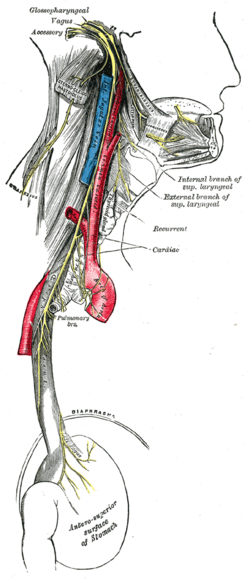
Back عصب بلعومي لساني Arabic Dil-udlaq siniri Azerbaijani Nervi glossofaringi Catalan Jazykohltanový nerv Czech Nervus glossopharyngeus German Nervio glosofaríngeo Spanish Keele-neelunärv Estonian Nerbio glosofaringeo Basque عصب زبانی حلقی Persian Nerf glossopharyngien French
| Glossopharyngeal nerve | |
|---|---|
 Plan of the upper portions of the glossopharyngeal, vagus, and accessory nerves. | |
 Course and distribution of the glossopharyngeal, vagus, and accessory nerves. (Label for glossopharyngeal is at upper left.) | |
| Details | |
| To | Tympanic nerve |
| Innervates | Motor: stylopharyngeus Sensory: Oropharynx, Eustachian tube, middle ear, posterior third of tongue, carotid sinus, carotid body Special sensory: Taste to posterior third of tongue |
| Identifiers | |
| Latin | nervus glossopharyngeus |
| MeSH | D005930 |
| NeuroNames | 701, 793 |
| NeuroLex ID | birnlex_1274 |
| TA98 | A14.2.01.135 |
| TA2 | 6320 |
| FMA | 50870 |
| Anatomical terms of neuroanatomy | |
| Cranial nerves |
|---|
|
The glossopharyngeal nerve (/ˌɡlɒsoʊfəˈrɪn(d)ʒiəl, -ˌfærənˈdʒiːəl/[1]), also known as the ninth cranial nerve, cranial nerve IX, or simply CN IX,[2] is a cranial nerve that exits the brainstem from the sides of the upper medulla, just anterior (closer to the nose) to the vagus nerve. Being a mixed nerve (sensorimotor), it carries afferent sensory and efferent motor information. The motor division of the glossopharyngeal nerve is derived from the basal plate of the embryonic medulla oblongata, whereas the sensory division originates from the cranial neural crest.
- ^ "Glossopharyngeal | Definition of Glossopharyngeal by Oxford Dictionary on Lexico.com also meaning of Glossopharyngeal". Lexico Dictionaries | English. Archived from the original on March 12, 2021.
- ^ Verberne, Anthony J. M. (2003-01-01), "Medulla Oblongata", in Aminoff, Michael J.; Daroff, Robert B. (eds.), Encyclopedia of the Neurological Sciences, New York: Academic Press, pp. 54–63, doi:10.1016/b0-12-226870-9/00785-1, ISBN 978-0-12-226870-0, retrieved 2020-12-31